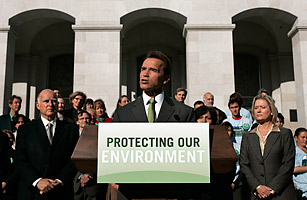
Cap-and-trade may be dead nationwide, but the defeat of Proposition 23 removed perhaps the last obstacle in the way of California developing its own carbon-cutting program. At the end of October, California's powerful Air Resources Board released hundreds of pages of proposed regulations that will help California — which is, on its own, the eighth-biggest economy in the world — to cut some 273 million metric tons of CO2 or its equivalent between 2012 and 2020.
California has the advantage of watching and learning from Europe's own struggles with a cap-and-trade system, and most of the new rules are designed to cushion the impact of a carbon cap on the state's economy, which is still suffering through double-digit unemployment. Still, this is uncharted territory. Agriculture, utilities, industry, transportation — the rules are Byzantine and will be controversial. And California will be embarking on this experiment mostly on its own. But the history of environmental change in the U.S. is one of the Golden State moving first, and the rest of the country reluctantly following. Maybe that will be the case on climate as well.